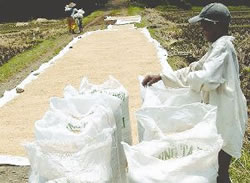Land Grab Diminishes Rice Production: Bali
 The face of Bali has changed dramatically over the last four decades from a peaceful ‘village’ to one of hectic tourism and an array of villas and houses sprouting up along the coastline.
The face of Bali has changed dramatically over the last four decades from a peaceful ‘village’ to one of hectic tourism and an array of villas and houses sprouting up along the coastline.
The appeal of ‘living in paradise’ has seen an influx of foreigners retiring in Bali or staying for extended periods of time. This massive land grab has resulted in less being available for rice production.
Government targets to increase local rice production in Bali as part of a national plan to grow 2 million more tons of rice nation-wide in 2007 are going to be hard to achieve. In the case of Bali, the major obstacles to more rice production are lower-than-average rainfall and the uncontrolled conversion of agricultural lands to other uses according to an article in the Bali Discovery.
Speaking to the Indonesian-language daily Kompas, Bali’s Chief of Agriculture, Dewa Nyoman Suarta, blamed land use conversion as the biggest culprit in the downturn in rice production in Bali, causing a growing dependency on other areas for the Balinese staple crop.
According to statistics kept by the Department of Agriculture, the subak irrigated areas in Bali are diminishing at a rate of between 700 and 1,000 hectares per year. 1,612 active subak areas are currently estimated to cover 82,095 hectares in Bali. In 1997, just one decade ago, there were an estimated 3,000 subak occupying 87,850 hectares still in operation. In the space of a decade, that’s a -6.55% decrease in community-controlled land dedicated to rice agriculture.
The Agriculture Chief for Bali said the loss of farming land was due to the high prices being offered to farmers in order that their lands could be devoted to industrial and real estate applications.
Because of this, it is increasingly unlikely that Bali will meet a target of 805,000 tons of rice and other grains set for the current year.